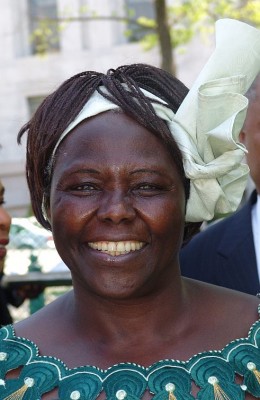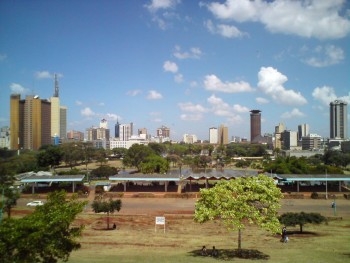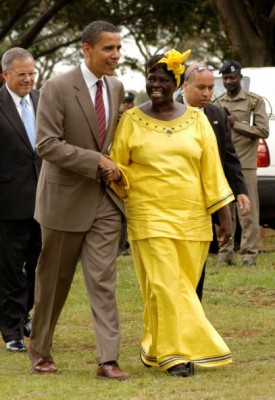Wangari Maathai (1940-2011)
Global fame, national battles, and an ambivalent legacy

On 5 June 2020, on World Environment Day and speaking from the Nairobi Arboretum, President Uhuru Kenyatta celebrated one of Kenya’s most iconic figures: Wangari Maathai. The president introduced her not as an environmental activist or as a former politician, but as the “Nobel Peace Laureate, Professor Wangari Maathai”. Praising the way she dedicated her life to the protection of the environment, he added that “We must emulate Wangari’s example, and show by our stewardship that we too are worthy heirs.” Uhuru Kenyatta had carefully chosen his words: he was celebrating Maathai as a global figure, that of the first African woman to be awarded the Nobel Peace Prize in 2004. But he left aside the more controversial details of her personal and political biography. Herein lies the ambiguous power of global exposure: while it gave Maathai new fame, it can also be used to overshadow her challenge of the Kenyan political establishment.
Early global connections
Born into a family of Kikuyu peasants on 1 April 1940 in the village of Ihithe (Nyeri district, Central Province of the then British Kenya) Maathai received, very early on, a literary education, which, as she wrote in her autobiography, “changed [her] life!” (40). After an outstanding primary and secondary education, the doors to a more global academic career opened. Maathai was one of the few women to benefit from the “Kennedy Airlifts”, which provided scholarships for promising students to access higher education in the United States. In 1964, five years after she graduated from high school, she obtained her college degree in biological sciences from Mount St. Scholastic College in Atchison, Kansas.
While education abroad was still largely reserved for a male-dominated elite, Maathai was soon hailed as a “female academic wonder”. She returned to Kenya in 1966, took a job at the Department of Veterinary Anatomy at the University of Nairobi, and eventually became the first woman to be the Chair of the Department. She completed further studies in Germany and, in 1977, became the first woman in East and Central Africa to earn a doctorate degree and the first woman to be appointed associate professor at the University of Nairobi.
That same year however, she abandoned her academic career to dedicate herself to the environmentalist cause in which she had been developing interest since childhood. Already well versed in the (women’s) associative world (she was then prominent in the Nairobi Branch of the Kenya Red Cross Society and the National Council of Women of Kenya) she established the Green Belt Movement (GBM), an association devoted to tree planting, community development and (rural) women’s empowerment to solve Kenya’s deep-rooted poverty and gender inequalities. As a well-educated woman and an environmental activist, fighting, what is more, for women’s economic, social and to a certain extent political rights, Maathai was openly challenging the patriarchal and masculine norms of Kenyan society. It was not long before she was seen as a troublemaker.
The “indomitable” divorcee speaks out
Sadly, 1977 was also the year of her separation from her husband, Mwangi Mathai, a businessman and member of parliament with whom she had three children. Two years later, Mwangi went to court to formalize the divorce. Divorces were still rare at the time, and, as Maathai recalled, “were granted only on grounds such as cruelty, adultery, mental torture, or insanity” (145). Her case was all the more extraordinary in that “it was popular like a soap opera” (145). Her husband accused her of adultery as well as being “too educated, too strong, too successful, too stubborn, and too hard to control” (146): she was too independent a woman, too far away from the traditional gender roles ascribed to women, wives and mothers. She simply did not meet the requirement of the (male) idea of the “proper woman”, submissive and silent (Ebila, 2015). Maathai denied all charges but the divorce was granted. She nonetheless refused to abandon her husband’s name and added an “a” to her last name as a sign of resistance and independence.

Wangari Maathai’s divorce quickly resurfaced as her commitment to the protection of the environment became increasingly politicized. Her ceaseless fight against Daniel arap Moi’s Kenya Media Trust Tower project, a 60-storey building that was to be constructed in Uhuru Park, has made history. Back then, her image as an “indomitable divorcee” did not play in her favour. As the case was discussed in parliament for the first time in November 1989, a local newspaper noted that “Angry members of parliament spent about 45 minutes in vitriolic attacks on Maathai”. She nonetheless relentlessly denounced the government’s policies of “development with destruction” (Weekly Review, 17 November 1989). Her outspoken resistance, mobilization of international political networks and the public demonstrations she organized, succeeded in turning international investors away from the project. It not only forced President Moi to step back but signalled one of the first cracks in his dictatorial regime. Her later defence of both Nairobi’s Jeevanjee Gardens and Karura Forest in the 1990s further established her not only as a leading environmental activist but also as a pioneering opposition activist, fighting for the return of democracy and multiparty rule.
Global networks, limited politics?
Maathai had been a woman of the networks she skilfully used to challenge political, economic and social conventions. As Grace Musila emphasized, Maathai demonstrated the “possibility of a clanked alliance of forces between local agency and international support.” (Musila, 2020, 41). From the 1980s onwards, she was part of various global campaigns not only raising awareness about environmental issues and other forms of global violence, but also fighting for greater political, social and economic global equality. Her US education was certainly instrumental in giving her the rhetorical means to establish various transnational alliances, raise financial and solidarity support, and gain international media attention (Musila 2020, 42 and Roy, 2011).

But more than just a global discourse, Maathai was one of the pioneer activists who managed to use international connections to advance a national political agenda. The way she succeeded, for example, in having the Nairobi-based United Nations Environment Programme on her side during her campaign for the Karura Forest had much greater political consequences: it signalled a strategic rapprochement between international and civil society organizations, at a time international politics were about to take a new turn with the fall of the Berlin Wall and the coming end of the Cold War. Her environmental activism had always been about economic and political empowerment, and so Maathai unsurprisingly became a leading figure of the politicization of civil society and the demand for the democratization of Kenyan politics in the early 1990s (Musila, 53-54).
And yet, Maathai never succeeded in establishing a political career. She campaigned twice unsuccessfully for the presidential elections, in 1997 and 2002, and finally acted as an elected member of parliament for Tetu (her place of birth) in the Nyeri district, from 2002 to 2007. In 2003, she was appointed assistant minister in the Ministry for Environment and Natural Resources and served in that capacity until November 2005. She was awarded many prizes but is perhaps most famous for being the first African woman to be awarded the Nobel Peace Prize in 2004. Thereafter, she continued her environmental advocacy through her NGO work. She died on 25 September 2011 at the age of 71, after battling with cancer.
Despite her formidable achievements and her ground-breaking political and environmental imagination, Maathai’s legacy remains torn between the global fame she acquired and the troublesome figure she continues to represent for the Kenyan national elite. As Nanjala Nyabola skilfully put it, Maathai “is beloved by feminists and environmentalists, and tolerated by everyone else” while her legacy is as “a victim of both the casual misogyny and the political schizophrenia that characterizes Kenya’s public sphere” (Nyabola, 2015). It seems to be a classic case of global fame acquired by one woman on a mined battlefield that remains too unstable for her country to accept and adjust to it.
Archives, online sources and bibliographical references
- Ebila, Florence. “‘A Proper Woman, in the African Tradition’: The Construction of Gender and Nationalism in Wangari Maathai’s Autobiography Unbowed.” Tydskrif vir letterkunde 52, no.1 (2015): 144-154.
- Maathai, Wangari. Unbowed. London: Arrow Books, 2008.
- Musila, Grace A.. Wangari Maathai’s Registers of Freedom. Cape Town: Human Sciences Research Council, 2020.
- Nyabola, Nanjala. “Wangari Maathai Was Not a Good Woman. Kenya Needs More of Them.” African Arguments, 8 October 2015.
- “President Kenyatta Pays Tribute To Wangari Maathai As He Leads The Nation In Marking World Environment Day,” Website of the Office of the President, 5 June 2020.
- The Weekly Review.
Further reading
- Graness, Anke. “Ecofeminism in Africa. The Contribution of Wangari Maathai.” In Jonathan O. Chimakonam and Louise du Toit, African Philosophy and the Epistemic Marginalization of Women. Abingdon; New York: Routledge, 2018.
- Kanogo, Tabitha. African Womanhood in Colonial Kenya, 1900-50. Oxford: James Currey, 2005.
- Nzomo, Maria “Kenyan Women in Politics and Public Decision Making,” African Feminism: The Politics of Survival in Sub-Saharan Africa (1997): 232-256.
- Njeru, Jeremia. “‘Defying’ Democratization and Environmental Protection in Kenya: The Case of Karura Forest Reserve in Nairobi.” Political Geography no. 29 (2010): 333-342.
- Worthington, Nancy. “Shifting Identities in the Kenyan Press: Representations of Wangari Maathai's Media Complex Protest, Women's Studies in Communication, 26:2 (2003): 143-164.


